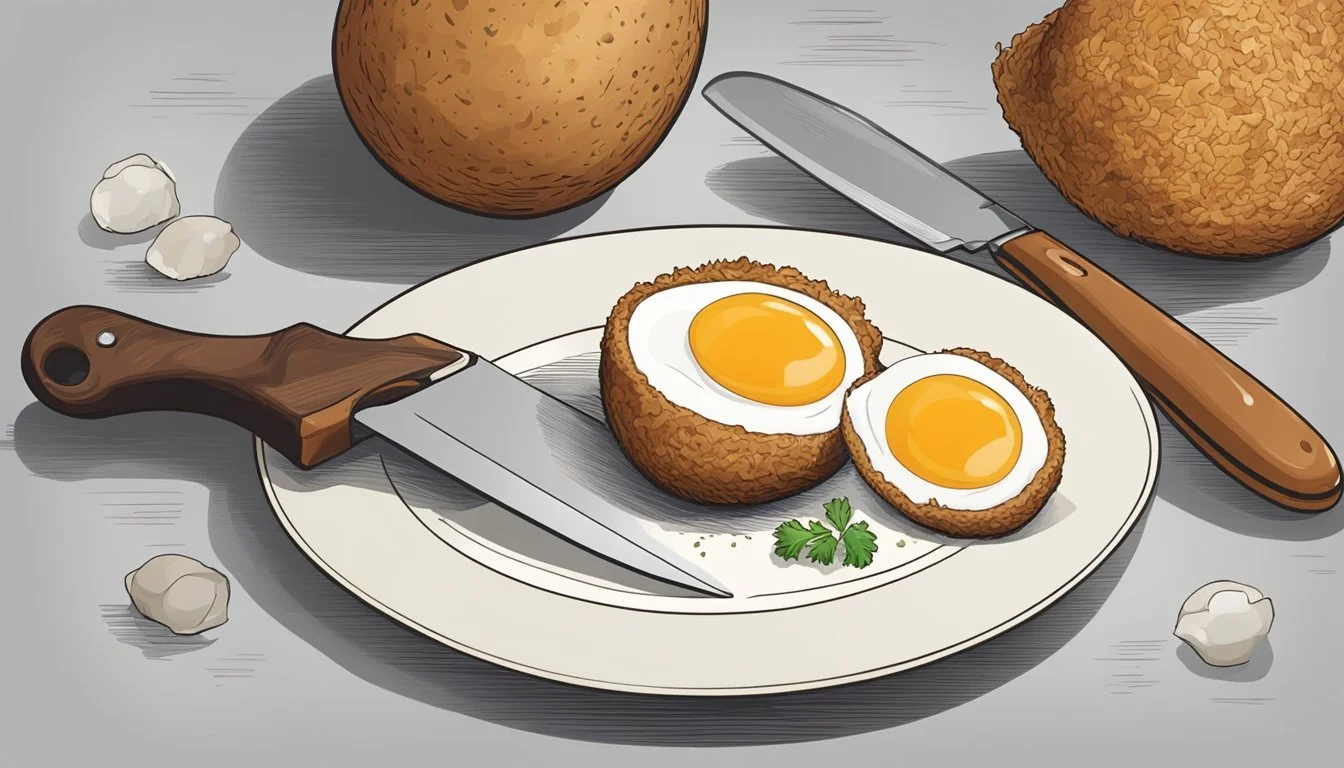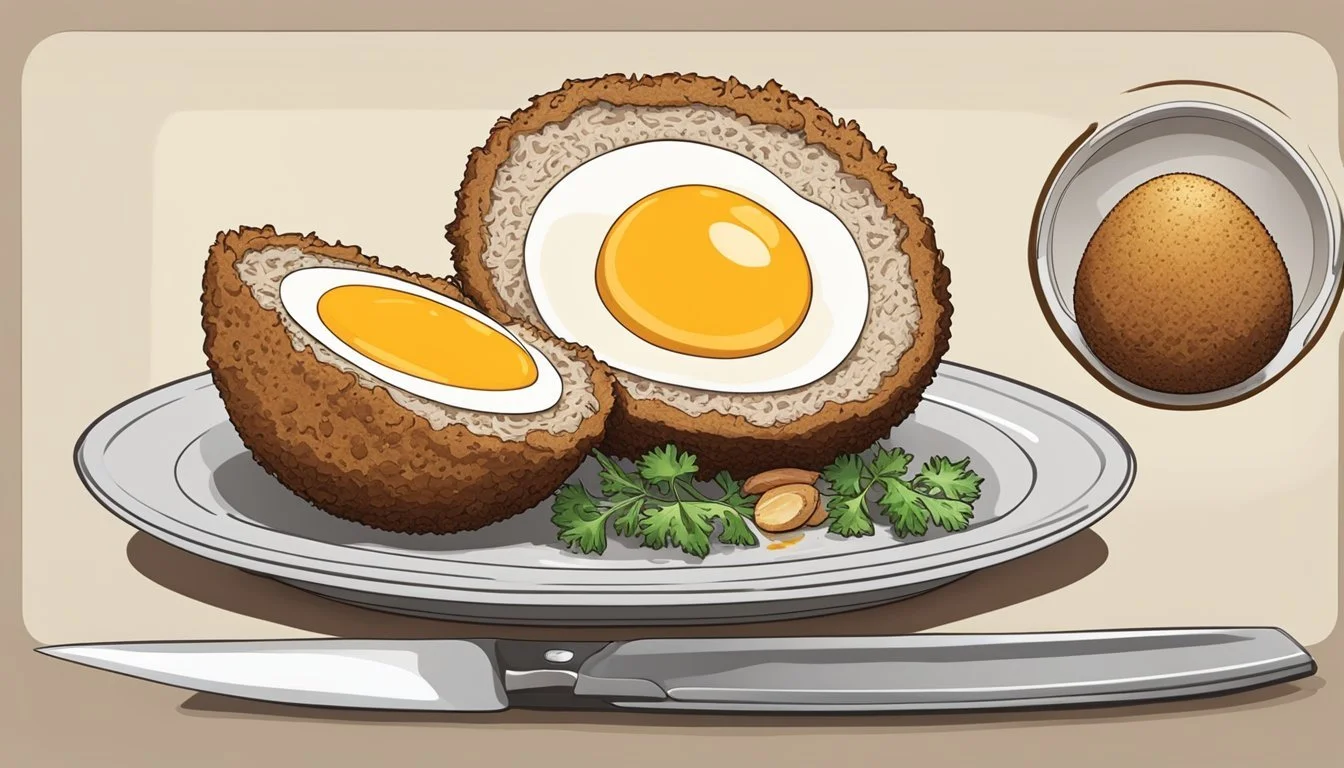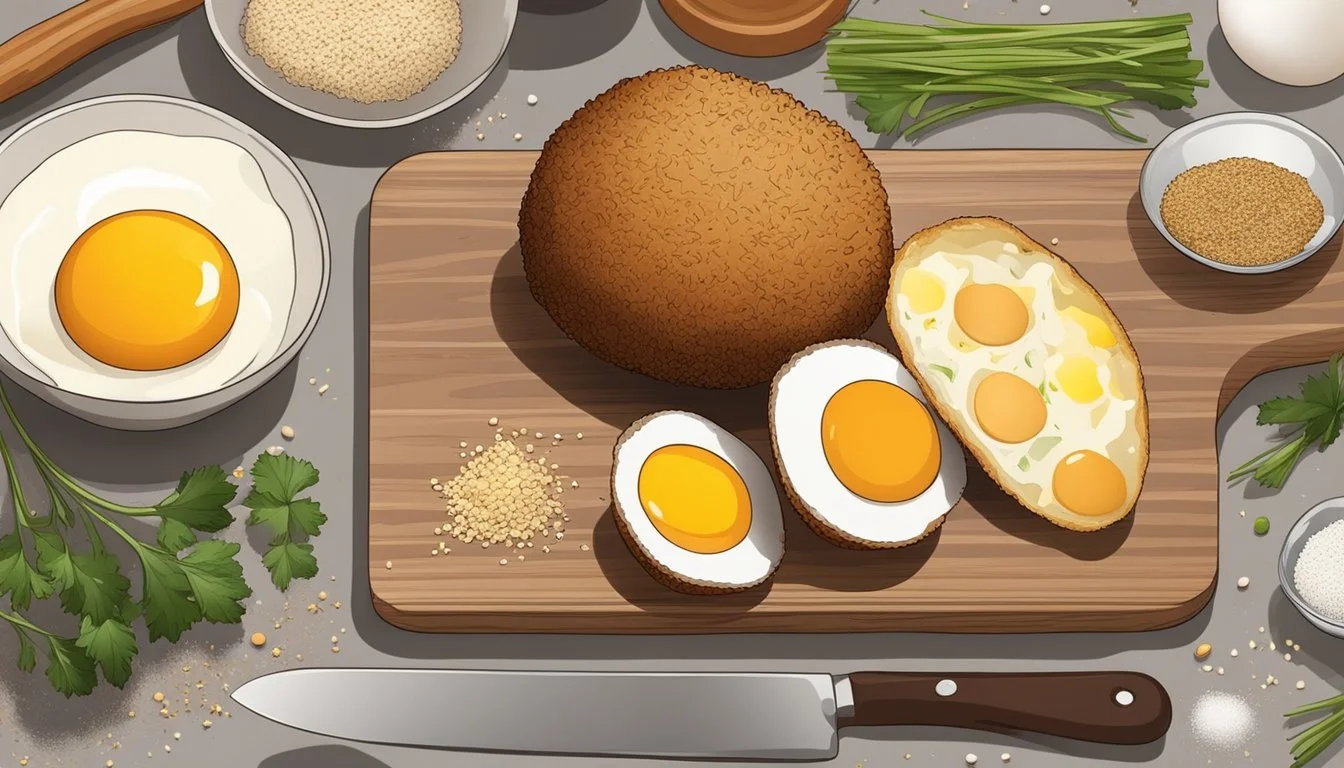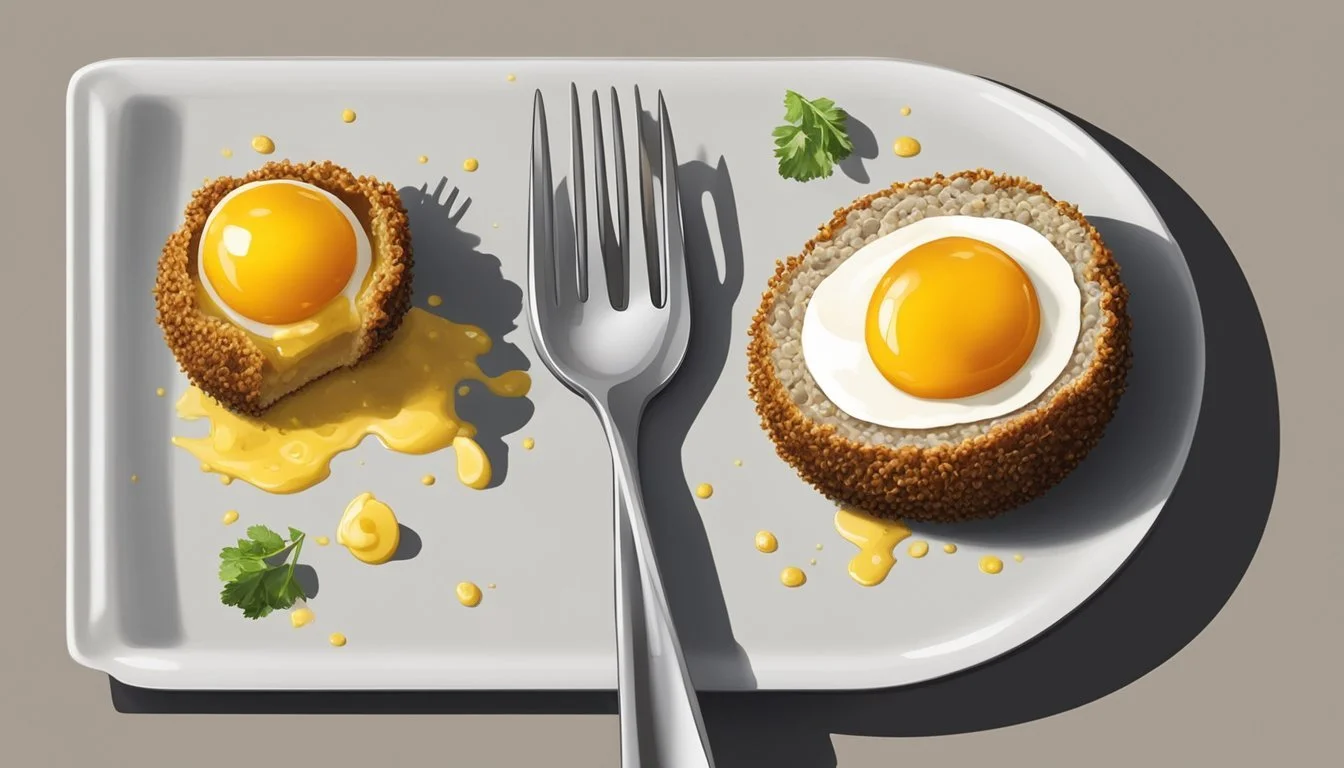How do you eat a Scotch egg?
Unveiling the Proper Technique
A Scotch egg is a quintessential British dish, embodying a traditional culinary practice from the U.K. that dates back centuries. At its core, the dish consists of a hard or soft-boiled egg encased in a layer of savory sausage meat, then breaded and deep-fried to golden perfection. It's a hearty food item that combines different textures and flavors, enjoyed by many across England as a staple snack or part of a meal.
Enjoying a Scotch egg typically requires no complex rituals or culinary skills. It can be eaten whole or cut into halves or quarters to reveal the layers and cooked egg at the center. This English classic is often found in pubs and on picnics, serving as a satisfying, portable snack that has withstood the test of time.
The traditional Scotch egg offers a balance of seasoned meat with the subtle flavors of the egg, complemented by a crunchy breadcrumb exterior. They can be enjoyed hot or cold, making them versatile for various occasions. While the original recipe remains popular, there have been many interpretations, including those that cater to specific dietary needs or gourmet variations that incorporate unique ingredients or condiments for a modern twist on the classic.
History and Origin
The Scotch egg, a British classic, has a contested but fascinating origin story. Its beginnings are often linked to Fortnum & Mason, a prestigious London department store, which claims the creation of the Scotch egg in 1738. They assert that it was commissioned as a convenient meal for travelers.
Despite Fortnum & Mason's claim, alternative theories exist about its inception. It is speculated that Scotch eggs may have been an adaptation of the Indian dish "nargisi kofta"—a similar concept involving an egg encased in spiced meat.
Another narrative suggests a more humble beginning for the Scotch egg, proposing that it was a northern English variation of the Cornish pasty, designed as an easily portable lunch for the working class. This snack would have provided a practical solution to consuming a meal without the need for utensils, simplifying the dining process for those on the move.
In British culture, the Scotch egg has found its home not only as a picnic staple but also within the realm of pubs and gastropubs, gaining popularity as a satisfying and hearty finger food.
Year Event 1738 Fortnum & Mason claims to create Scotch egg 19th Century Scotch eggs appear as pub and picnic fare
As its history is debated, what remains clear is the Scotch egg's firm standing as a gastronomic emblem in Britain, championed for its portability, taste, and the role it plays in the traditional pub experience.
Nutritional Information
A Scotch egg typically comprises a hard or soft-boiled egg wrapped in sausage meat, coated in breadcrumbs, and baked or deep-fried. As a substantial snack or part of a meal, it offers a combination of protein, fat, and carbohydrates. The nutrition profile of a Scotch egg can vary depending on the size and specific ingredients used, but a general breakdown for a standard Scotch egg is as follows:
Calories: Approximately 270-300
Fat: Approximately 16-17 grams
Protein: Around 14 grams
Carbohydrates: About 15-20 grams
Protein Content: The egg provides high-quality protein, which is essential for muscle repair and growth. Additionally, the sausage meat adds extra protein, making a single Scotch egg a good protein source.
Fat Composition: It's important to note that the fat content is relatively high due to the sausage meat and the cooking method. The type of fat will vary based on the meat used, with a higher proportion of saturated fat often found in traditional recipes.
Carbohydrate Content: Scotch eggs contain a moderate amount of carbohydrates from the breadcrumbs, which offer a quick energy source. However, they are not a significant source of dietary fiber.
When integrating a Scotch egg into one's diet, one should consider it as part of their overall daily nutritional intake, especially if one is monitoring calorie and fat consumption. Although it can fit into a balanced meal plan, moderation is key due to its calorie density and fat content.
Ingredients Overview
A superb Scotch egg combines a harmonious balance of quality ingredients with precise seasoning. This section explores what goes into crafting this classic picnic favorite.
Main Components
Eggs: The centerpiece is a boiled egg, often preferred with a slightly jammy yolk, but they can range from soft to hard-boiled based on personal preference.
Sausage Meat: Traditionally, high-quality sausage meat is essential, enveloping the egg. It can be from a range of meats, with pork being the most common.
Breadcrumbs: These provide the final crispy coating, usually fine dry breadcrumbs work best for an even, golden-brown finish.
Seasonings and Flavorings
Herbs and Spices: A blend of sage, thyme, and pepper is commonly mixed into the sausage meat for a complex flavor profile.
Salt: Vital for seasoning both the sausage meat and the egg, it should be used judiciously to enhance the overall taste.
Mustard: Often added to the meat mixture for an additional tangy kick, enhancing the Scotch egg's savory quality.
Optional Additions
Flour: For a light dusting before the egg is coated in sausage meat, aiding in the adhesion of the breadcrumbs.
Additional Herbs and Spices: Garlic, mace, nutmeg, chives, and parsley can be incorporated according to the recipe or personal taste for more nuanced flavors.
Black Pudding: Some recipes introduce minced black pudding into the sausage meat for a deeper, richer taste.
Accompaniments: Scotch eggs can be paired with a variety of condiments, from classic English mustard to fruity chutney, harmonizing with the richness of the dish.
Preparation Techniques
Proper preparation of Scotch eggs involves specific techniques to ensure the egg is cooked correctly and the coating achieves the desired crisp texture. These steps are crucial for creating a satisfying Scotch egg.
Boiling Eggs
To start, one must boil the eggs carefully to achieve the perfect consistency. Place eggs in a pan with enough cold water to cover them completely. Once the water boils, reduce the heat and simmer for five minutes. Then, transfer the eggs to a bowl of iced water to stop the cooking process and make peeling easier.
Wrapping the Egg
After peeling the boiled eggs, one must wrap each egg in seasoned sausage meat. For this, take sausage meat with casings removed, flatten it, and evenly wrap around the egg. If needed, clingfilm can be used to help shape the sausage meat around the egg.
Breading Process
Next is the breading process. Roll the wrapped egg in all-purpose flour. Afterwards, dip it into a bowl of beaten egg, ensuring it’s completely coated. Finally, roll the egg in panko breadcrumbs or regular breadcrumbs for a crisp outer layer.
Cooking Methods
There are different cooking methods that can be used. To deep-fry, heat vegetable oil to 175°C (350°F) in a deep pan, then fry the eggs until they are golden brown. Alternatively, to bake, preheat an oven to a similar temperature and cook the Scotch eggs on a baking sheet until they are golden and crisp. An air fryer can also be used for a healthier option, resulting in less oil but still achieving a crispy texture.
Serving and Presentation
When presenting and serving Scotch eggs, one should ensure that the eggs are golden brown and that the yolk remains runny if preferred. Presentation can range from simple to elegant, suiting environments from pubs to gastropubs, and occasions like breakfasts, picnics, or as an appetizer on a buffet.
How to Serve
The classic Scotch egg, with its crisp exterior and soft center, is typically served at room temperature or slightly warm. It’s a versatile food item that can be enjoyed as a satisfying main dish or as a hearty snack. For a complete meal, these eggs can also be halved or quartered to showcase the runny yolks, making them a visually appealing centerpiece for any plate.
Sauces and Condiments
A range of sauces and condiments can elevate the flavors of Scotch eggs:
Mustard Sauce: English mustard or a milder mustard sauce offers a tangy contrast.
Chutney: Sweet and spicy chutneys, like pineapple, add a fruity note.
Dipping Sauces: Traditional ketchup, ranch dressing, or hollandaise sauce provide creamy and familiar flavors.
Accompaniments
To complement Scotch eggs:
Salads: A fresh watercress salad or coleslaw can balance the dish with a light, crisp texture.
Potatoes: Mashed potatoes or potato wedges/chips offer a satisfying starch component.
Beans: Homemade baked beans lend a comforting taste and are a staple side in British cuisine.
Pairing these eggs with the right side dishes and condiments can create a balanced and delicious experience suitable for a variety of settings, from a casual meal at a pub to a dish at a picnic or buffet.
Storage and Make-Ahead Tips
When preparing Scotch eggs in advance, it's essential to store them properly to maintain their quality. After cooking, Scotch eggs can be kept in the refrigerator. To do this, one should wait for the eggs to cool to room temperature. Then, they can be placed in an airtight container or wrapped tightly in clingfilm to prevent them from drying out. This method keeps them fresh for up to three days.
For those planning to consume Scotch eggs over a more extended period, freezing is a viable option. The eggs should be wrapped individually in clingfilm and then placed in an airtight container or heavy-duty freezer bags. In the freezer, Scotch eggs will keep for about one month. However, the quality is best when consumed within two weeks.
When one is ready to enjoy their Scotch eggs, they can be reheated in an air fryer set at 350°F (180°C) for about 4-5 minutes. If they are not heated thoroughly, they should be heated for a few additional minutes. Remember, reheating times may vary based on the appliance and whether the Scotch eggs are refrigerated or defrosted.
Top Tips:
Cool down: Always let Scotch eggs cool completely before storing.
Wrap well: Use clingfilm or airtight containers to protect against dryness and odors.
Label: If freezing, label the eggs with the date to keep track of freshness.
Reheat safely: If reheated, ensure the food has reached a safe internal temperature before consuming.
Variations of the Scotch Egg
The Scotch Egg, a versatile dish traditionally served as a snack or appetizer, has evolved with numerous variations that cater to different tastes and occasions.
Traditional vs Modern Twists
Traditionally, a Scotch Egg consists of a soft-boiled egg enclosed in sausagemeat, coated in breadcrumbs, and then deep-fried to achieve a crispy exterior. Modern twists on the Scotch Egg have seen it transformed into more than just a picnic staple, with chefs introducing ingredients like chorizo or black pudding in place of standard sausagemeat. These variations offer a range of flavors, satisfying those seeking a customary experience or a novel taste.
Alternative Coatings
While breadcrumbs remain the conventional choice for Scotch Egg coatings, alternative options like panko breadcrumbs have gained popularity for their lighter, crunchier texture. Some recipes even swap out the breadcrumbs entirely for a layer of seeds or crushed nuts, providing a different flavor profile and a gluten-free option.
Meat Substitutes
For those who do not consume traditional sausagemeat, meat substitutes offer a way to enjoy Scotch Eggs. Common alternatives include casings removed from vegetarian sausages or plant-based mince, which are seasoned to emulate the original's taste. These substitutes are often used to encase the egg before it's coated and cooked, keeping the dish accessible for a variety of dietary preferences.
Different Cooking Techniques
While deep-frying is the classic method of cooking a Scotch Egg, baking or air frying are popular for their health benefits, resulting in fewer calories and less fat. The eggs can be baked in a preheated oven or cooked in an air fryer to achieve a similar crispness to frying. Regardless of the technique—bake, air fry, or fried—the goal remains to ensure a crisp exterior with a well-cooked layer of sausagemeat around the egg.
Pairings with Scotch Eggs
Enjoying a Scotch egg—whether as a pub snack, a picnic treat, or a hearty lunch—calls for thoughtful accompaniments that complement its rich and savory flavors. Here are recommended pairings that will enhance the overall dining experience:
Sides:
Salads with crisp greens and light dressings balance the dish's richness; a simple watercress salad or a Caesar salad works well.
Sausage rolls can be a hearty addition for a more substantial meal, especially suitable for gatherings.
Baked beans, with their sweetness and smooth texture, offer a classic and comforting side option.
Side Dish Description Watercress/Caesar Salad A crisp and refreshing contrast to the Scotch egg. Homemade Baked Beans Adds a sweet tang that complements the egg's savory notes. Sausage Rolls Provides a substantial, meaty addition.
Condiments: Bold condiments such as English mustard provide a spicy kick that cuts through the egg's richness. Mustard's heat pairs well with the Scotch egg's seasoned meat coating.
Beverages: A cold beer is a classic pairing choice, ideally a British ale, completing the traditional pub fare experience. The beer's carbonation and bitterness contrast nicely with the richness of the Scotch egg, cleansing the palate between bites.
To sum up, when selecting partners for a Scotch egg, one should aim for balance and contrast, considering the heaviness of the dish, the sharpness of condiments, and the fresh simplicity of side salads. These combinations ensure that each bite of the Scotch egg remains as satisfying as the first.
Where to Find Scotch Eggs
Scotch eggs are a traditional British dish that can be enjoyed in various settings, from casual to gastronomic experiences. They are widely available across the U.K. and are especially popular in eateries and retail outlets that focus on British cuisine.
Restaurants and Pubs
One can find Scotch eggs served in a variety of restaurants and pubs across the U.K., from the classic pub to the upscale gastropub. These establishments often take pride in offering authentic Scotch eggs made from quality ingredients. They are typically enjoyed as a hearty snack or a starter:
Classic Pubs: Known for their traditional fare, Scotch eggs here are served with a customary accompaniment of mustard or pickle.
Gastropubs: These eateries may put a creative spin on the traditional Scotch egg, pairing it with contemporary or artisanal sauces and sides.
Retail and Supermarkets
For those preferring to savor Scotch eggs at home, supermarkets provide a convenient option. Many retail outlets across the U.K. stock pre-made Scotch eggs, both in traditional and gourmet varieties:
Local Supermarkets: Ready-to-eat Scotch eggs can be found in the chilled foods section, offering a quick snack or picnic item.
Gourmet Food Shops: Some retailers specialize in artisan Scotch eggs, with options that might include organic or free-range eggs and premium sausage meat.
In both restaurants and retail environments, the quality of a Scotch egg can vary, so one is encouraged to seek out establishments known for their focus on freshness and culinary expertise.
Health Considerations
When indulging in a Scotch egg, one should be mindful of its nutritional profile. A typical Scotch egg consists of a hard or soft-boiled egg wrapped in sausage meat, coated in breadcrumbs, and then baked or deep-fried. Acknowledging the preparation method and ingredients is crucial for dietary considerations.
Nutrition: Generally, Scotch eggs are a source of protein due to the egg and meat content. However, the nutritional value can vary based on the ingredients used.
Protein Content: The eggs and sausage meat provide a good amount of protein which is vital for muscle repair and growth.
Salt Content: The sausage meat in Scotch eggs can be high in salt, contributing to the daily sodium intake. Overconsumption of salt is associated with increased blood pressure and risk of heart disease.
Fried Foods (What wine goes well with fried foods?): If the Scotch egg is fried, it may contain higher levels of fat, particularly saturated fat. This can affect heart health if consumed in large quantities. Opting for a baked Scotch egg can reduce the fat content.
Nutrition Label Breakdown (Approximates per average Scotch egg):
Calories: 300-400
Protein: 15-20g
Fat: 20-25g
Saturated: 5-10g
Carbohydrates: 10-15g
Sugars: Less than 1g
Fiber: 1-3g
Sodium: 500-1000mg
Individuals looking for a healthier version may consider using leaner meats, reducing the size of the Scotch egg, or altering the cooking method to baking. It is advisable to enjoy Scotch eggs in moderation as part of a balanced diet.
Cultural Significance
The Scotch egg is deeply embedded in British culture, symbolizing a traditional British classic that resonates with pub culture as well as outdoor dining like picnics. It holds a place as a staple in pubs across the U.K., with its presence expanding to more upscale establishments like gastropubs, where chefs might reimagine this hearty snack with gourmet twists.
Pubs: Often found in the familiar setting of a British pub, the Scotch egg offers a savory treat that pairs well with a pint of ale or beer.
Gastropubs: Pushing beyond tradition, gastropubs have elevated the Scotch egg, playing with flavors and presentation while maintaining the essence of the comfort food.
Picnics: Due to its portability, the Scotch egg is a favored choice for picnics, acting as a compact, yet filling, addition to outdoor meals.
In the sphere of tradition, the Scotch egg's versatility allows for it to be enjoyed hot or cold, showcasing the methods of consumption that have been passed down over generations. The traditional Scotch egg, with its simple yet satisfying combination of a hard or soft-boiled egg encased in sausage meat and breadcrumbs, continues to be celebrated as part of the U.K.'s culinary heritage.
Tradition and Innovation: While the traditional Scotch egg remains popular, contemporary variations also exist, reflecting diverse culinary influences and the innovative spirit within British gastronomy.
This savory treat encapsulates a sense of British identity and culinary tradition, uniting diversity in taste and presentation under the banner of a beloved national dish.











